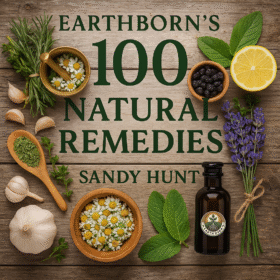-
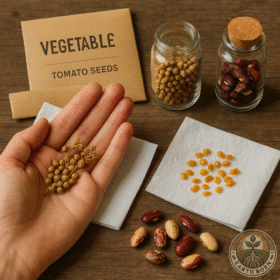
🌱 Saving Seeds: Grow Your Own Future
Saving seeds is one of the oldest gardening traditions—and one of the smartest things you can do for your garden. It helps preserve heirloom varieties, adapt your plants to your local conditions, and saves you money every year. Whether you grow food, herbs, or flowers, learning to save seeds means you can create a garden uniquely yours. 💚 Why Save Seeds? Cost-effective: Skip buying seeds every year. Preserve heritage: Protect heirloom vegetables and medicinal herbs like basil, coriander, and lavender. Local adaptation: Your plants will naturally adjust to your soil and climate over time. Sustainable gardening: Less packaging, shipping, and… Read more…
-

🌿 6 Herbs That Love Epsom Salts—and Why You Should Try It in Your Garden 🌿
If you’ve ever wondered whether your herbs could use a little mineral boost, Epsom salts might be your secret weapon. Rich in magnesium sulfate, Epsom salts help plants produce more chlorophyll, improve nutrient uptake, and encourage lush growth. Here are 6 herbs that thrive with a sprinkle of Epsom salts: Basil🪴 Why it loves Epsom salts:Magnesium fuels basil’s leafy growth, making your plants fuller and more aromatic. A magnesium boost helps prevent yellowing leaves. Rosemary🪴 Why it loves Epsom salts:Rosemary benefits from improved root development. Epsom salts also help this Mediterranean herb stay vigorous, especially in containers. Sage🪴 Why it… Read more…
-

🌿 What Are Your Plant Leaves Trying to Tell You? 🌿
Your plants are constantly communicating with you—even if they can’t speak. One of the easiest ways to understand what your plants need is to look closely at their leaves. Here’s a simple guide to help you diagnose common problems and bring your plants back to vibrant health: 🍃 Nitrogen Deficiency Signs: Yellow or pale green leaves, stunted growth. Fix: Add coffee grounds to the soil to give your plants a nitrogen boost. 🍌 Potassium Deficiency Signs: Leaves turning yellow and brown at the edges and tips. Fix: Mix banana peels into the soil to replenish potassium. 🥚 Calcium Deficiency Signs:… Read more…
-

🌿 12 Homemade Fertilizers Every Herb Gardener Should Know 🌿
Why buy chemical fertilizers when your kitchen scraps can feed your garden naturally? Here’s how to turn everyday waste into powerful plant food — and which herbs love them most! 🟡 1. Banana Peels🔹 Use: Chop and bury near roots or soak in water for a potassium boost.🔹 Best for: Lemongrass, Comfrey, Chamomile, and Lavender — all benefit from potassium for strong root development. ☕ 2. Coffee Grounds🔹 Use: Sprinkle used grounds around plants to improve soil acidity and add organic matter.🔹 Best for: Parsley, Sage, Rosemary, Thyme, and Blueberries — acid-loving herbs thrive here. 🥚 3. Eggshells🔹 Use: Crush…
-
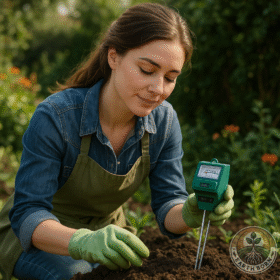
🌱 No Need to Feed Your Plants — Feed the Soil Instead! 🌿
Want lush, thriving plants? Don’t focus on feeding the plant — focus on feeding the soil. Healthy soil is alive — teeming with microbes, fungi, earthworms, and organic matter. When you care for the soil, it becomes a self-sustaining ecosystem that naturally provides everything your plants need to grow strong, resilient, and nutrient-rich. 🔄 Nature’s Secret:Plants don’t eat fertilizer — they absorb nutrients released by soil life. If your soil is rich in organic matter, humus, and biological activity, your plants will flourish without the need for constant external inputs. In South Africa, where climates vary from region to region,… Read more…
-
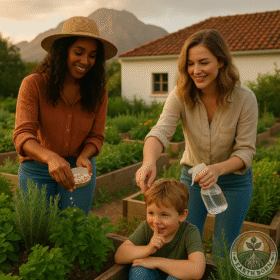
🌱 Natural Homemade Fertilizers for Your Herbs: What Works Best and How to Use Them
Keeping your herbs lush, aromatic, and full of nutrients doesn’t require expensive store-bought fertilizers. Your kitchen already holds powerful, natural alternatives! Below, we explore 5 natural fertilizers you can make at home — plus exactly which herbs love them most and how to use them effectively. ☕ 1. Coffee Grounds – Rich in Nitrogen Best for: Basil, Parsley, Mint, Chives Coffee grounds are slightly acidic and packed with nitrogen, a key nutrient for leafy herbs that thrive on strong foliage growth. How to Use: Dry used coffee grounds completely. Sprinkle a thin layer directly onto the soil, then water in…
-
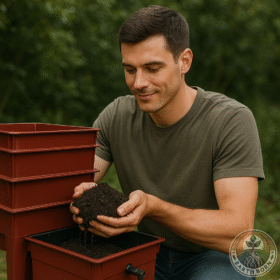
🪱 Earthworms – Nature’s Soil Magicians
Earthworms are the quiet heroes beneath our feet, working tirelessly to improve soil health, plant growth, and overall garden vitality. Whether you’re an organic gardener, a homesteader, or simply curious about sustainable soil practices, understanding earthworms is key to building a thriving ecosystem. 🔍 How to Identify Earthworms Earthworms are long, cylindrical, segmented creatures ranging in color from pink to reddish-brown. You’ll often spot them after rain or while digging in moist soil. Here are key features to help you identify them: Length: Typically 5–15 cm (2–6 inches), though some species grow longer. Segments: Their bodies are divided into rings… Read more…
-
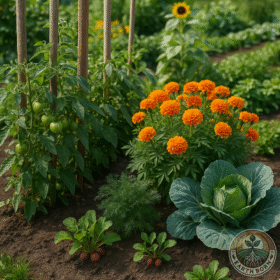
🌿 Top 10 Companion Plants for a Healthier Organic Garden
In organic gardening, nature is your best ally. Companion planting is the art of pairing plants that help each other grow—whether by repelling pests, enriching the soil, or boosting pollination. Here are 10 of the best companion plants to create a thriving, chemical-free garden. 🌱 1. Basil + Tomatoes This dynamic duo isn’t just great in the kitchen! Basil repels aphids, whiteflies, and hornworms while improving tomato flavor and growth. 🌼 2. Marigolds + Almost Everything Known as the guardian of the garden, marigolds deter nematodes, aphids, and whiteflies. They work well alongside tomatoes, beans, and brassicas. 🥕 3. Carrots…
-
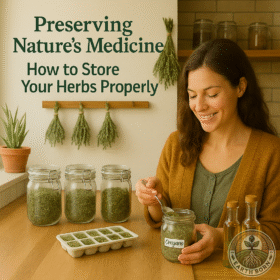
🌿 Preserving Nature’s Medicine: How to Store Your Herbs Properly 🌿
Your homegrown herbs are packed with healing power – but only if you store them correctly! 💚 Here are some Earthborn-approved tips to help you keep your herbs fresh and effective for months to come: 🧺 1. Drying HerbsHang small bunches upside down in a warm, dry, and well-ventilated place away from direct sunlight. Once fully dry and crisp, crumble them gently and store in airtight glass jars. Ideal for teas, remedies, and cooking! ❄️ 2. Freezing HerbsChop your herbs and freeze them in ice cube trays topped with water or olive oil. Use a cube in cooking to instantly…
-
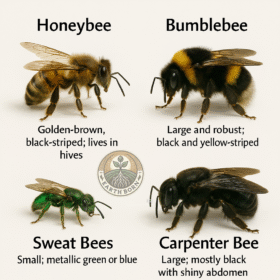
🐝 Bees in the Garden: Friends, Foes, and Finding Balance
Bees are some of the most fascinating and important visitors to our gardens. They bring life, color, and an essential service we often take for granted – pollination. But, like any relationship with nature, understanding bees helps us know when to welcome them — and when a little caution is needed. 🌸 Types of Bees You Might See Honeybees: These are the classic golden-brown bees we think of first. Highly social, they live in large colonies and are responsible for much of the pollination in gardens and farms. Bumblebees: Larger, rounder, and fuzzy, bumblebees are gentle giants of the bee…
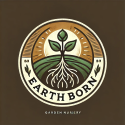

 **Meet Sprout!** Sprout is your friendly gardening companion at Earthborn, always ready with helpful advice on plant care, medicinal herbs, and natural gardening solutions. From seedling to harvest, Sprout provides expert guidance to nurture your garden and your well-being—making gardening easy, fun, and naturally rewarding.
**Meet Sprout!** Sprout is your friendly gardening companion at Earthborn, always ready with helpful advice on plant care, medicinal herbs, and natural gardening solutions. From seedling to harvest, Sprout provides expert guidance to nurture your garden and your well-being—making gardening easy, fun, and naturally rewarding.
